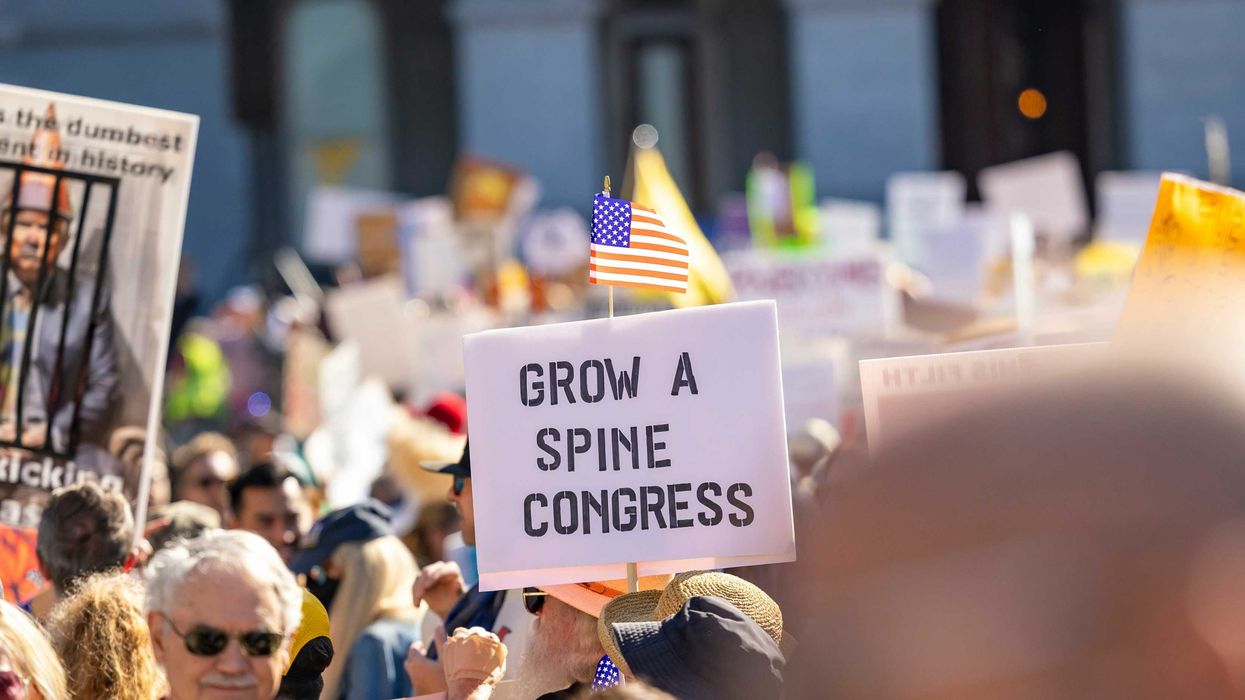No matter who they voted for on Election Day, it has become clear that most Americans agree on at least one thing: Our current form of democracy no longer works. Almost three-quarters of us agree that “the U.S. used to be a good example of democracy, but isn’t anymore.” The question before us now is whether we can build a better one.
Two years ago, I wrote two parallel essays about the attitudes of party elites: “ Why Progressives Don’t Get Democracy ” and “ Why Conservatives Don’t Get Democracy.” In this presidential campaign, the two parties spent over $10 billion between them. The Harris campaign emphasized the threat posed by Donald Trump and implied that if voters would simply elect Democrats, democracy would be saved, Americans could leave the work of governance to experts and elected officials, and we could all relax into post-Trump normalcy. The Trump campaign claimed that its candidate could almost single-handedly solve the nation’s problems and avoided using the term “democracy” altogether.
The limited, frustrating and expensive version of democracy we have today, where parties tout voting as the main way for Americans to participate in governance, isn’t compelling to Democratic, Republican or independent voters. Our system has failed to deliver the benefits and changes we want. It doesn’t make people feel like they have a voice, or that they matter.
At the local level, Americans remain heavily involved in democratic activities that show how much they can matter. In fact, our Healthy Democracy Ecosystem Map shows 10,000 groups and organizations in America doing democracy-strengthening work: supporting service and volunteerism, expanding civic education, supporting youth leadership, and providing civic technologies and media, among many other valuable pursuits. These democracy-builders include Democrats, Republicans and independents, and they are working all over the country.
My organization, the National Civic League, was established at another time when the country was dealing with polarization, urban-rural divides and economic inequality; it was founded in 1894, by Teddy Roosevelt and Louis Brandeis. Over the following 20 years, it helped convert activities and innovations into systemic changes to democracy, including the model city charter, the ballot initiative and referendum process, and suffrage for women. That civic infrastructure served us well overall; now the system needs an upgrade, badly.
The Building Civic Bridges Act, championed in Congress by Reps. Derek Kilmer (D-Wash.) and Andy Barr (R-Ky.) and Sens. Chris Coons (D-Del.) and Todd Young (R-Ind.), would provide a bipartisan foundation for better civic infrastructure. What are the innovations and reforms that could be incorporated in that infrastructure? Here are 10:
1. Make citizens’ assemblies part of our policymaking process. In a citizens’ assembly, a group of ordinary citizens comes together to learn about, deliberate on and make recommendations about an important public issue. These groups typically range from 30 to 100 people, and they are carefully assembled to represent the community in terms of age, gender, race, politics and other demographics. The group meets for a number of days over several weeks or months and submits its final recommendations either to elected officials (who have committed upfront to carefully considering them) or to the voters who will consider them when voting on a ballot initiative. Like our jury system, assemblies rely on the ability of diverse people to learn, weigh evidence and find common ground.
2. Let people vote directly on more issues and policies. The use of initiatives and referenda arose during that earlier period of innovation a century ago. They have been successful recently in expanding Medicaid and protecting reproductive rights. It is a reform in need of an upgrade: Ballot measures are often written in confusing language, and voters don’t always know enough about the issue. But when combined with citizen’s assemblies, digital tools like ActiVote, uses of generative AI to summarize and translate, and other opportunities for learning and discussion, they can produce changes in places where legislatures are gridlocked or out of touch with citizens.
3. Give people a say on budgets. Participatory budgeting (PB) was one of the first ideas to spread around the world during the recent period of democracy innovation. In PB, citizens generate and refine ideas for how to spend a pot of money, ranging from hundreds to millions of dollars. Participants often work in teams that connect with experts and staff, leading to a vote where everyone in the community can evaluate the ideas and allocate the funds. Some PB processes have a second tier in which neighborhood participants are selected to advise the overall city budget. PB has been shown to reduce inequality, improve health and boost voter turnout.
4. Change official public meetings. Most of the meetings held by city councils, school boards, planning commissions, state agencies and other bodies continue to use the same format they have for decades: People are allowed three minutes at the microphone to address the officials, on any topic they choose, with almost no interaction between citizens, officials or staff. These meetings produce frustration on the part of both citizens and officials, allow extreme voices to dominate discussion and seem to erode public trust. Small-group deliberations and digital tools can make these sessions more civil, informed and productive, and allow people to participate meaningfully before and after the meetings.
5. Use digital tools to support in-person deliberation. Fifteen years ago, it seemed as though the internet would revolutionize democracy; more recently, it seems just as likely to destroy it. Digital tools offer so many ways to help people brainstorm ideas, rate public services, identify problems, aggregate opinions, raise money, envision policy options, share neighborhood information and craft statements that reflect the consensus of a group. We have learned that these tools need to be used in concert, and they must be connected to in-person discussion: Technological communication and face-to-face interaction have different strengths and complement each other well. This sort of tech-enabled deliberation is particularly important for helping people decide how to maximize the positives, and minimize the dangers, of artificial intelligence.
6. Renovate the civic associations that represent the “ground floor” of democracy. The associations that should be most accessible to ordinary people are in bad shape. Neighborhood groups, local online networks, parent councils, citizen academies, and local boards and commissions should offer ways for people to connect, build bridges, solve problems and give input to government. Instead, most are run by a few exhausted volunteers who usually aren’t representative of the larger community. Many tech tools could be helpful — but so could the more old-fashioned approach of highly regular meetings, centered on food, that are primarily social events with a bit of public engagement.
7. Give voters more meaningful roles in campaigns. Candidates currently spend massive amounts of money on ads and one-way messaging. If they engaged voters in more of a two-way discussion, using deliberative processes and tech tools to jointly develop key aspects of their platforms, they might gain supporters, inform citizens and refocus races on policies rather than personalities. Having established that pattern during the campaign, officials would be more comfortable engaging citizens when in office — and citizens would be more likely to get engaged.
8. Regularly review and update city charters and the legal framework for democracy. Most city charters have a review clause: Every 10 years or so, the city must by law create a commission to evaluate the charter (which is essentially the constitution for the city) and decide if it should be updated. This makes sense: Our legal frameworks for democracy should fit the needs and goals of citizens today. One reason why official public meetings are so dysfunctional is that the open meetings laws in some states were written in the 1970s and are hard to interpret for the internet. In other, younger democracies, there is more innovation in part because charters and constitutions were established more recently, and people know they can be changed when they aren’t working well.
9. Use award programs and international exchanges to celebrate and learn from successes. For 75 years, the All-America City Award has recognized the work of communities in using inclusive civic engagement to address critical issues. Those local successes should be lifted up, as well as innovations and reforms in other countries. We have federal agencies that support democracy abroad, but none that focus on democracy at home; as a result, we have fallen behind many other countries, where people have implemented a wide range of reforms. Events like the World Forum on Democracy and the Global Innovations in Democracy parliamentary exchange bring elected officials and others together to learn from one another.
10. Measure and evaluate democracy. It is hard to improve something if you aren’t measuring it, and for decades practically the only way we have measured democracy is by tracking voter turnout. There are many tools and technologies we can use to rate, evaluate and assess our civic opportunities. Above all, we need to know how people react to different innovations and reforms, and what they think about their community as a result of these changes: Do they feel more connected to others, are they getting the information they need, do they have a more meaningful say on decisions they care about and is their volunteerism supported and honored? Fundamentally, do they feel like they matter and belong?
There are no magic bullets on this list. In fact, some of these innovations don’t work so well on their own and need to be combined with other ideas. All of the ideas on the list should be considered potential ingredients of a comprehensive package of reforms — like the one we crafted 100 years ago.
While none of these items are labeled specifically as “bridge-building” or “civic education,” all of them serve those ends. Many of them can reduce partisan polarization by bringing diverse people together around decisions or issues of shared concern. All of them further civic education, and help defeat misinformation, by creating settings where people learn together.
Do Americans want these kinds of reforms? The biggest challenge is that most citizens — and even most officials — are unaware that these ideas exist. But when they find out about them, such as in the national Yankelovich Democracy Monitor opinion poll conducted by Public Agenda, they support them. “The democratic reforms Americans favor are the ones that give people the most direct power over decisions — specifically participatory budgeting, ballot initiatives, and citizen juries,” stated the report. Support was strong, ranging from 66 percent to 83 percent, and did not vary greatly between Democratic and Republican respondents.
If the incoming Trump administration wants to live up the long Republican tradition of supporting individual rights and local control of decision-making, it should advocate for some of these ideas. But if it doesn’t, there are other ways to move forward: the democracy reforms of a century ago started at the local and state levels, and we can do that again now. And in Congress, the Building Civic Bridges Act offers the hope of federal support for local innovation. The Healthy Democracy Ecosystem Map highlights just how much of that innovation is already taking place and identifies access points for volunteers and funders looking for places to help.
Renovating our democracy seems like a big job. But the green shoots of innovation have grown despite an overall lack of attention, funding and government support. They are developing steadily here and thriving even more in other countries. We are already devoting resources to our political system: billions of dollars and countless hours of labor for campaigns. By making even a fraction of that effort to support innovation and reform, we can help Americans achieve the democracy they want.
Leighninger directs the Center for Democracy Innovation at the National Civic League.


















